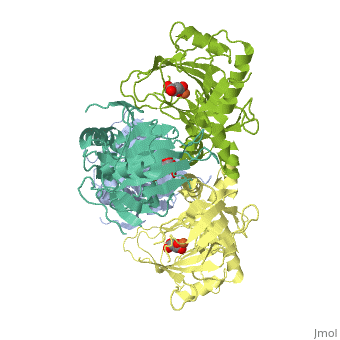1vz4
Fe-Succinate Complex of AtsKFe-Succinate Complex of AtsK
Structural highlights
FunctionATSK_PSEPU Catalyzes the oxigenolytic cleavage of 2-ethylhexyl sulfate (2-EHS) in the presence of alpha-ketoglutarate to yield 2-ethyl-hexanal and succinate, the decarboxylated form of alpha-ketoglutarate. It can accepte a wide range of alpha-keto acids including 2-oxo-valerate, 2-oxo-adipate, 2-oxo-octanoate, 3-methyl-2-oxo-butyrate, oxaloacetate-alpha-ketoadipate, and alpha-ketooctanoate. It can catalyze the cleavage of medium-chain alkyl sulfate esters such as butylsulfate, pentylsulfate, hexylsulfate, heptylsulfate, octylsulfate, nonylsulfate, decylsulfate and sodium dodecyl sulfate (SDS).[1] Evolutionary ConservationCheck, as determined by ConSurfDB. You may read the explanation of the method and the full data available from ConSurf. Publication Abstract from PubMedThe alkylsulfatase AtsK from Pseudomonas putida S-313 is a member of the non-heme iron(II)-alpha-ketoglutarate-dependent dioxygenase superfamily. In the initial step of their catalytic cycle, enzymes belonging to this widespread and versatile family coordinate molecular oxygen to the iron center in the active site. The subsequent decarboxylation of the cosubstrate alpha-ketoglutarate yields carbon dioxide, succinate, and a highly reactive ferryl (IV) species, which is required for substrate oxidation via a complex mechanism involving the transfer of radical species. Non-productive activation of oxygen may lead to harmful side reactions; therefore, such enzymes need an effective built-in protection mechanism. One of the ways of controlling undesired side reactions is the self-hydroxylation of an aromatic side chain, which leads to an irreversibly inactivated species. Here we describe the crystal structure of the alkylsulfatase AtsK in complexes with succinate and with Fe(II)/succinate. In the crystal structure of the AtsK-Fe(II)-succinate complex, the side chain of Tyr(168) is co-ordinated to the iron, suggesting that Tyr(168) is the target of enzyme self-hydroxylation. This is the first structural study of an Fe(II)-alpha-ketoglutarate-dependent dioxygenase that presents an aromatic side chain coordinated to the metal center, thus allowing structural insight into this protective mechanism of enzyme self-inactivation. Succinate complex crystal structures of the alpha-ketoglutarate-dependent dioxygenase AtsK: steric aspects of enzyme self-hydroxylation.,Muller I, Stuckl C, Wakeley J, Kertesz M, Uson I J Biol Chem. 2005 Feb 18;280(7):5716-23. Epub 2004 Nov 12. PMID:15542595[2] From MEDLINE®/PubMed®, a database of the U.S. National Library of Medicine. See AlsoReferences
|
| ||||||||||||||||||
